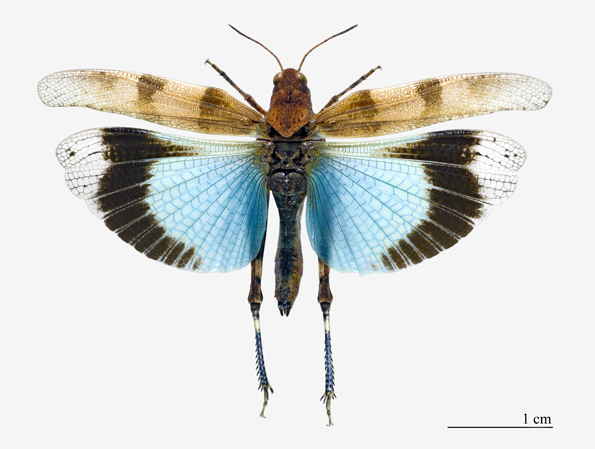
I believe that the beauty and diversity of the creation are evidences of the love of God for his children.
Blue-winged Grasshoppers
Our son was about nine when he came home from the summer fields with closely cupped hands and announced that he had found a grasshopper with blue wings. I was skeptical. I have seen grasshoppers with red, black, yellow, orange, and transparent wings, but I had never seen one with blue wings. “No, not blue wings,” I said. “There aren’t any.”
He looked at me for a moment, without speaking, and then opened his hands. Bright, deep, metallic blue–real blue–flashed in the afternoon sun. In an instant, the insect was gone. I stared after it in amazement, then caught my breath, glanced upward, and said very, very softly, “Thanks.” It came to me then, as it often has, that the beauty and variety of creation are powerful evidence of God’s love.
On a visit to Hawaii to celebrate twenty-five years of marriage, my wife and I rejoiced at the beauty of sea and mountain. We visited fern rainforests and towering waterfalls and rejoiced in the profusion of flowering plants, trees, and bushes. Every evening and morning prayer contained words of gratitude.
One afternoon we visited the Volcanoes National Park and traversed a desolate landscape, almost lunar in its sterility. It occurred to me then that a Being as all-powerful as God could have created just such a place for the testing and mortal experiences of His children-a world without the color and beauty and diversity of life that had so delighted us-and sent us there to work out our salvation. Instead He sent us here, to a home away from home, but one overflowing with loveliness and variety.
Is it conceivable that the only purpose of this diversity is to maintain some precarious ecological balance? Are grasshoppers with blue wings necessary to preserve the earth in its orbit and the biosphere in its many functions?
And even if grasshoppers are necessary, would not the red and orange and black-winged ones suffice? I do not know, of course. I am not an entomologist. But I am a child of God with eyes and a heart. I know that grasshoppers with blue wings are surprisingly beautiful, and I know that God made them, and I know that He loves me. My testimony of the relationship of that love and that beauty is enough.
Photographing Frogs
I have wondered if our Father in Heaven and His Son did not call us together to participate in some pre-mortal field trip following the creation so that we could examine our future home. In such a gathering one of them might have said, “Children, you can see that we have made something for you-something very, very beautiful. Mortality is a test and will often be difficult, but while you are so far away, we want you to know that we love you. Open your eyes and your heart and you will know.”
I once prepared a multimedia presentation on the creation in an attempt to teach that message. In the process I spent hundreds of hours with my camera, finding and framing images that would communicate to others my feelings about the love of the Father and the Son.
I spent a significant amount of time taking pictures of frogs. I confess that I do not find frogs beautiful. Sunsets and roses speak more clearly to my heart. But I believe that the variety of the creation stands next to its beauty as evidence of divine love. God made things not only “to please the eye and to gladden the heart,” but to “enliven the soul” (D&C 59:18,19).
I wanted to convey that truth as well. Frogs enlivened my soul! I discovered that hundreds of species of frogs inhabit this planet. Some are as small as stinkbugs, others large as house cats: yet all are the work of the Son of God, for “without him was not anything made that was made” (John 1:3).
Which of us has not stared in wonder at the intricate and incredible designs on a butterfly wing or the radiant hues of a brilliant rose. We know these are the fruit of Christ’s creative genius. But it was while photographing frogs that I began to cherish that creative genius.
The Creative Genius of the Father and the Son
My eye was pleased and my heart gladdened on a late summer afternoon on the Mogollon Mesa. I was driving out of Snowflake toward Heber, Arizona. The day had been bathed by intermittent thunderstorms rolling back and forth across the sky. In the lengthening shadows of the afternoon, the clouds had drifted together to form a dome of grey, dripping vapors that floated above the mesa like the inverted canopy of a great parachute.
The smell of wet sage and Indian paintbrush swept in through the open window of my Malibu, while small, distant storms draped rain like somber linen curtains from the clouds above. I observed a narrow band of blue at the horizon before me, where the storm clouds had not closed off the sky. As I drove, the sun slipped into the azure streak, and a transformation of such beauty took place that I stopped the car and got out.
Between one breath and the next the underside of the canopy of clouds was transformed from a gelatinous mass of gray vapors into a radiant maze of flaxen canyons and golden, towering, castles. The somber linen curtains of rain became cascades of golden tinsel, hanging from the underside of heaven.
This demonstration of the creative genius of the Father and the Son lasted less than five minutes. Not another car passed. No one else was there to notice the spectacle. But I had noticed! Returning to my car to continue my journey, I paused just a moment, aware that my soul had been enlivened. I glanced upward and whispered, “Thank you!”
The Beauty and Variety of the Creation
Several years ago I traveled with my wife to a family reunion in Estes Park, Colorado.
As we traversed Rocky Mountain National Park, we climbed and climbed, the pavement hugging the edges of precipitous cliffs that fell away in a haze of hidden canyons and rocky gorges thousands of feet below. And we climbed! Half a dozen times we came to places where the road crossed a ridge line, and we thought that we had certainly reached the top. Then we would look to the far side of the next valley and see the road still ascending! We were traveling the highest paved highway on earth.
Stunning vistas flowed away in every direction: glacial lakes and emerald meadows, herds of elk and deer. Spectacular pine forests blanketed rolling hillsides and immense valleys. Magnificent, snow-capped peaks stretched skyward on every side. Our emotions were stirred by continual waves of gratitude.
Is there a soul with eyes and a heart that could pass by such splendor with indifference? Do not all God’s children have a divine capacity to be both moved and inspired by the spectacular beauty and variety of His creations?
We miss an opportunity to remind ourselves of the love of the Creator when we do not acknowledge those inspired feelings of gratitude and reverence. When we fail to perceive that the beauty and variety of the creation are evidence of the love of God for us, we miss opportunities to increase our trust and our devotion, and to convey true thankfulness, as we are commanded to do: “In every thing give thanks: for this is the will of God in Christ Jesus concerning you” (1 Thessalonians 5:18).
Worshipping in New Ways
Once we understand this truth, we learn to worship in new ways. When we are drawn upward by this divine gift of beauty and variety we can be strengthened against every kind of discouragement and distress. The world itself will provide us with endless sign posts pointing toward heaven.
When we not only agree with the Maker that everything He has made is very good (Genesis 1:31) but also realize that this is so because of His love, we begin to have experiences like my own with the blue-winged grasshopper and the rain-drenched sunset. If we will only perceive that the beauty and variety that enfold us are nothing less than the footsteps of the Father, the shadow of the Son–the earthly confirmation of divine love-then our determination to go to Them with our trials will be more constant, and we will begin to feel-and perhaps even to write-words like these:
Every soul sings. We who inhabit this world of startling beauty and delightful variety have felt our souls sing. We have the challenge to remember to reflect these feelings upward in prayers of gratitude. If we can do that during our journey home, our eyes will be pleased and our hearts will be gladdened. Our souls will be enlivened. And we will come to know and love the Creators better than we have ever known or loved Them before. As we recognize that we are surrounded by invitations to seek Them in our hours of sorrow, we will be more inclined to do so. Our awareness of the manifestations of Their love in the world around us will be a continuing reminder of us of Their love.
We are Loaded Daily with Divine Benefits
I came home from work one November in a light, cool rain. As I stepped from the van, I realized we had roses! Years ago my wife invited me to plant a lot of them by the fence in front of the house.
They have been lovely and attractive in late spring and into the summer. People stop to tell us how beautiful they are, and occasionally to ask permission to pick one or two for themselves.We always say “Yes” of course. The roses are not my creation. They are God’s. But I had never seen them blooming in November. I went for my camera and took pictures. While taking photographs, I remembered a verse of scripture. The reference is Psalm 68:19:
“Blessed be the Lord, who daily loadeth us with benefits . . .“
I zoomed in for a close-up of a beautiful pink rose covered with droplets of water and felt “loaded with benefits.” This is the only verse in the Standard Works that uses the verb “loadeth” and it seems like the perfect word to describe what we experience every day. I sensed that loading as I contemplated the delicate beauty of that rose.
Numbering those benefits would be impossible. If I were to begin early tomorrow morning and make a list of every earthly blessing-every good and beautiful thing—that comes to me from the hand of God, I would be writing till my arms fell off and I would still be losing ground. Benjamin, a Book of Mormon prophet, understood.
“I say unto you, my brethren, that if you should render all the thanks and praise which your whole soul has power to possess, to that God who has created you, and has kept and preserved you, and has caused that ye should rejoice, and has granted that ye should live in peace one with another-I say unto you that if ye should serve him who has created you from the beginning, and is preserving you from day to day, by lending you breath, that ye may live and move and do according to your own will, and even supporting you from one moment to another-I say, if ye should serve him with all your whole souls yet ye would be unprofitable servants” (Mosiah 2:20 – 21).
I believe that one of the purposes of that daily loading, of the beauty and variety if the Creation is to remind us frequently of the love of God.
(This article is adapted from chapter 4 of the book Be Not Afraid, by Ted L. Gibbons)


















